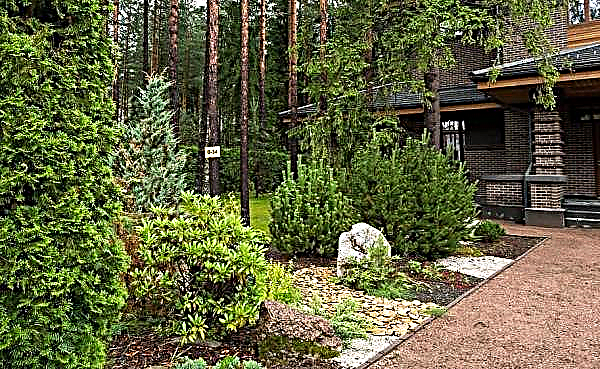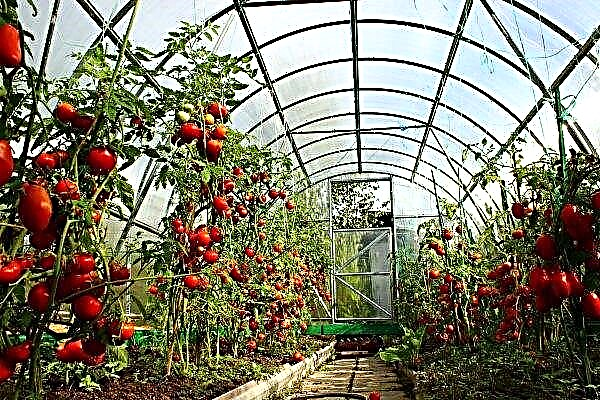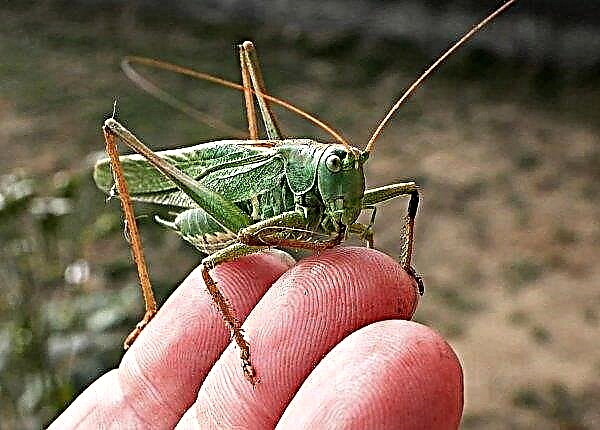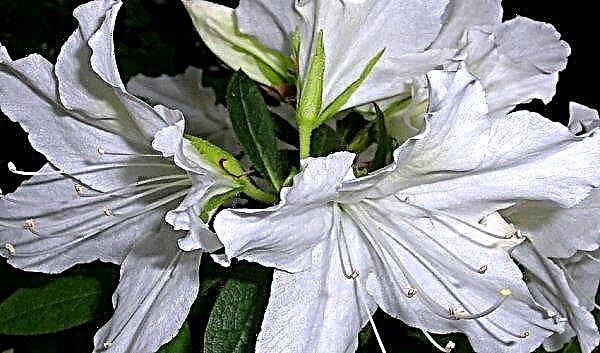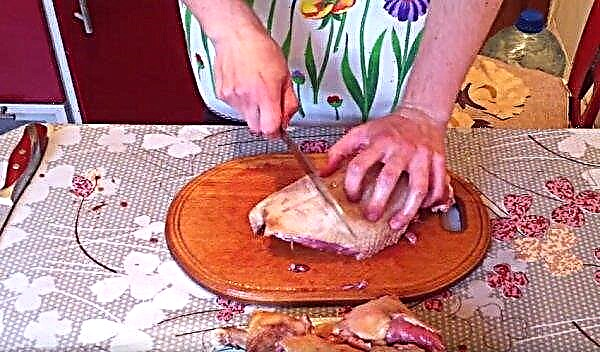Gloxinia is a beautiful indoor plant with bright large flowers of various colors. Experts say that it is not very capricious in care, but in practice, beginner flower growers can face many problems, most of which lead to a lack of long-awaited flowering. Find out what difficulties arise when growing gloxinia and how to quickly fix it.
The main diseases of gloxinia: symptoms and treatment methods
The most common cause of stunted growth and lack of gloxinia bloom are various fungal infections. For treatment to be effective, you need to learn to distinguish between their symptoms.
Did you know? Late blight is a disease so dangerous that the founders of Marxism seriously considered it as one of the causes of bourgeois-democratic revolutions in Europe. One way or another, late blight in the middle of the 19th century caused the famous Great Famine in Ireland, destroying almost the entire potato crop for four consecutive years.
Late blight
The causative agent of this most dangerous infection is the fungus. Phytophthora. The degree of harmfulness of this parasite is evidenced by its very name, literally translated from Greek as "plant killer". Phytophthora feels very bad in dry, warm, intensely lit soil with good ventilation, but as soon as at least one of these conditions is violated, the fungus instantly activates.
After only 7-10 days, the first symptoms of the disease can be observed on an indoor plant, namely:
- light plaque on the inside of the sheet plate;
- randomly located spots on the stem and the outer side of the leaf (spot color is brown, purple or brown, a characteristic feature is the presence of a light border);
- patches of soft rot in all aerial parts;
- if the disease has overtaken a plant during flowering, the buds dry and crumble.

Modern science has developed many fungicidal preparations that help to quickly and efficiently combat late blight. However, the problem is that most of them are extremely toxic, and therefore they cannot be used indoors. So - it is very important to recognize the “enemy" as soon as possible and try to defeat him with more gentle methods.
To do this, first of all, you need to remove all the affected fragments, and then carefully process the plant:
- a weak solution of potassium permanganate;
- infusion of garlic;
- aloe juice, diluted with water in equal parts;
- kefir diluted with water in a ratio of 1:10 and infused for 3-4 hours.
If the disease progresses, you can use a proven tool - a biological product "Fitosporin-M". It is non-toxic and completely safe.
Fusarium
Another name for this disease is tracheomycosis. Its causative agent is fungi of the genus Fusariumactivating at high humidity and insufficient watering. Unlike late blight, with fusarium, gloxinia leaves are not covered with plaque or spots, but simply fade, sag, first acquiring a watery structure, and then gradually drying out.

Particularly well, the development of the disease is visible on the upper part of the flower. Before treating gloxinia affected by fusarium, it is necessary to eliminate the causes that provoke the increased development of the fungus. The flower itself must be thoroughly washed with slightly warm water and treated with Fundazol. Usually the drug is used three times with a weekly break.
At the final stage of treatment, it is possible to treat the flower with Fitosporin-M, Previkur or Alirin-B. Benomil and Vectra drugs are also highly effective, but these drugs are quite toxic.
Gray rot
The causative agent of gray rot is the mold Botrytis. Like any fungus, it activates at high humidity, however, an additional factor that increases the likelihood of contracting this disease is not dry ground, but sudden changes in temperature.
Important! Gray rot spreads very quickly to neighboring plants, so the affected specimen should be immediately quarantined.
The characteristic symptoms of gray rot are brown spots on a leaf plate with a mildew-like gray coating. At first, the lesion foci are small, but soon they grow and merge into a single mass, becoming lighter and covered with a fluff characteristic of any mold. As the disease develops, the entire plant is captured, the stem is covered with light yellow rings, the buds soften and fall off without opening.
“Soft” preparations usually do not succeed in defeating the spreading fungus, which is why many flower growers immediately resort to potent fungicides.
In particular, the plant can be treated with such means as:
- Chorus
- Teldor;
- "Switch."
The advantages of these drugs are that, at high efficiency, they belong to the class of moderately hazardous to the environment and can be used even indoors, although with the observance of all necessary precautions.
Powdery mildew
Powdery mildew is another common disease of indoor plants that has a fungal nature. Infection usually occurs through soil or from contact with other colors. If the pot is in a well-lit place, and irrigation is carried out irregularly, the likelihood of developing an infection increases. The main symptom of powdery mildew is a whitish coating that appears on the back of the leaf, and small white spots on the outside.

Contrary to the existing misconception, these spots do not have a fibrous structure: the name “powdery” arose from the fact that in the first stages of the lesion the leaf looks like it was sprinkled with flour. Methods of control - treatment with home-made disinfectants (aloe juice, garlic, etc.) or the use of non-toxic fungicides and immunostimulants.
High efficacy against powdery mildew, in addition to the same Fitosporin-M, is shown by Gamair, Bactofit, Planriz and Pseudobacterin-2, as well as Immunocytophyte and Novosil.
Root rot
As the name suggests, root rot pathogens (and they can be various fungi, including the penicillas, phytophthora and fusarium mentioned above, as well as pitium, diplodia or rhizoctonia) do not develop on the green parts of plants, but underground, in the roots; more precisely, if we talk about gloxinia - tubers. Therefore, the external signs of damage are not so obvious.

However, as a rule, root rot is characterized by growth retardation and rapid flower wilting, and watering does not eliminate the situation, and sometimes even exacerbates it. With the development of the disease, the leaves begin to become covered with brown wet spots and fall off. In the end, the plant dies, that is, in the literal sense it rots “on the vine.” To combat the disease, it is most often necessary to urgently transplant a flower into a new pot with fresh soil.
As for special preparations, you can try to use for watering diluted in accordance with the instructions:
- Alirin-B;
- "Maxim";
- Trichodermin;
- "Tricholavitis";
- "Fundazole";
- Previkur;
- "Discourse";
- Mikosan
- Vitaros
- "Gamair";
- Glyocladin.
Important! Some experts recommend using the Topaz preparation to combat root rot of indoor plants, however, due to the very high toxicity of this agent, it is too dangerous to resort to it.
Chlorosis
Chlorosis is not a fungal infection, but a systemic disease associated with disruption of photosynthesis in the green parts of the plant. This condition is caused by a deficiency of minerals in the soil, primarily iron, as well as zinc, magnesium, nitrogen, etc. It is very easy to diagnose chlorosis: a leaf plate loses its juicy green color and becomes more yellow (veins can remain green).

In parallel, the disease is accompanied by other signs of weakening - growth retardation, reduction of the size of young leaves, drying of their tips, twisting, falling off, etc. The specific treatment of chlorosis consists in feeding gloxinia with iron, but this mineral must be in a chelated form (to be associated with organic acids ), otherwise the plant will not be able to absorb it.
It is easiest to use one of these drugs for watering and spraying:
- "Antichlorosis";
- “Ferovit”;
- Ferrilen
- Micro-Fe;
- "Brexil-Fe" and others.
Rust mushroom
It is more correct to call this disease a rust fungus or just rust. Various mushrooms belonging to the genus rusty can excite it - for example, Puccinia or Phragmidium.
Typical symptoms - brown, yellow, red or orange spots on the outside of the leaf plate and the so-called pustules (accumulation of fungi in the form of a kind of wart) - on the back. With the development of the disease, the spots increase in size and merge, the affected leaf turns yellow and falls off.

Among fungicides that are effective against rust pathogens, we can name such as:
- Oksikhom;
- "Gates";
- "Ordan";
- Bayleton;
- "Vectra";
- Abiga Peak;
- Home.
Did you know? The plant owes its name to the German botanist of the eighteenth century Benjamin Peter Gloksin. However, by an interesting coincidence, in German there is the word “glocke” meaning “bell”, which is very similar in shape to the gloxinia flowers (there is even a strong, albeit erroneous opinion that the word “gloxinia” comes from “glocke” ").
Anthracnose
Several types of fungi can cause this disease, in particular, Kabatiella, Gloeosporium and Colletotrichum. In this case, depending on the specific type of pathogen, the symptoms of the disease can vary greatly.
In particular, it is possible to suspect the development of anthracnose on gloxinia according to one of these signs:
- the appearance of small yellow spots on the leaves, in the center of which you can see a dark spot or, as the area of damage increases, a gray ring;
- the spots are larger, have a red or brown color and yellow fringing, the shape is round or oval, gradually in the affected area the tissue dries and crumbles, forming a hole;
- spots cover both leaves and stems, are large in size, brown in color, fluffy pustules are present inside the spot (in the first stages of the lesion, a darker depression is visible in the center of the spots).

You can fight anthracnose with the help of such means as Oksikhom, Abiga-Peak or Strobi.
Phyllosticosis
The causative agent of the disease is pathogenic fungi of the genus Phyllosticta.
The disease is diagnosed by the following characteristic signs:
- red or purple dots on the green parts of the plant;
- over time, each point grows into a spot with a darker edging, which gradually dries and crumbles, forming a hole;
- carefully looking at the affected areas, you can see the dark spores of round mushrooms.

Phyllosticosis can be cured even on those leaves where the foci of infection are visible, so it’s not worth ruthlessly removing all the fragments affected by the disease — you can try to treat the flower first.
To do this, you can use one of these fungicides:
- "Vectra";
- Oksikhom;
- "Gates";
- Abiga Peak;
- "Speed";
- "The keeper";
- "Vitaros".
Gloxinia pest management methods
In addition to diseases, the normal development of gloxinia can be impaired due to the fact that the plant was attacked by harmful parasites - insects and ticks. The following are the most common representatives of this category.
Spider mite
Traces of the life of the spider mite can be easily seen in the form of small bright spots on the leaves and characteristic strands of cobwebs, as if entangling individual parts of the plant. Having found such symptoms, it is necessary to carefully treat the stems and leaves with a cotton swab with a soap solution, alcohol or infusion of garlic or onions. Typically, such a procedure in the early stages is quite effective.

If the pest could not be destroyed, and repeated treatments also do not give a result, you can resort to acaricidal drugs, such as:
- Flumight
- "Actellicus";
- Fitoverm;
- "Skelt";
- Neoron
Cyclamen tick
This pest is clearly visible on the plant, if armed with a magnifying glass. Distinguishing it from other ticks and insects is quite simple - its body size of less than 1 mm is almost transparent. The flowers affected by the cyclamen tick quickly fade, and large colonies of the parasite are visible on the leaves, similar to dust.

A cyclamen tick is considered more dangerous than its spider web "relative". The control measures for these pests are the same, but in order to get rid of the cyclamen tick, it is necessary to carry out at least three treatments.
Thrips
Thrips are small insects that suck juice from a plant and completely disrupt its development. The defeat is manifested by the appearance of small bright spots on the aerial parts of the flower, as well as characteristic gray stripes on the front side of the leaves. Later, the dehydrated plate becomes brown, withers, folds and falls. The same thing happens with flowers.

You can deal with thrips on gloxinia with the help of neurotoxic drugs such as Apache, Dantop or Mospitan. Hormonal drugs that stimulate the production of chitin, such as Kiron, Pegasus, or Renegade, may also be effective. Stronger, but toxic drugs are insecticides: Nurel-D, Marshal, Bi-58, etc.
Shield
Scale is a small insect, covered with a dense shell, parasitizing on many indoor plants. You can recognize its presence by dense growths, similar to scales, appearing on the green parts of the flower and separating when trying to remove them.  In the early stages of a lesion, the usual treatment with soapy water or alcohol can help cure gloxinia, as in the fight against ticks. Among the insecticidal drugs that can be used in more severe stages, we can mention "Fosbetsid" or "Actellik".
In the early stages of a lesion, the usual treatment with soapy water or alcohol can help cure gloxinia, as in the fight against ticks. Among the insecticidal drugs that can be used in more severe stages, we can mention "Fosbetsid" or "Actellik".
Whitefly
It should be noted that among the huge variety of varieties of this insect on indoor plants, basically only one parasitizes - a greenhouse or greenhouse whitefly. The easiest way to recognize this tiny butterfly is to gently shake the gloxinia pot: insects in large numbers will rise into the air and easily find themselves.
On the back side of the leaf, notes of light egg laying are also good notes - another way to recognize whiteflies. The affected plant is covered with an unpleasant sticky coating, as the parasite multiplies, the leaves turn yellow, wilt, twist and fall off.
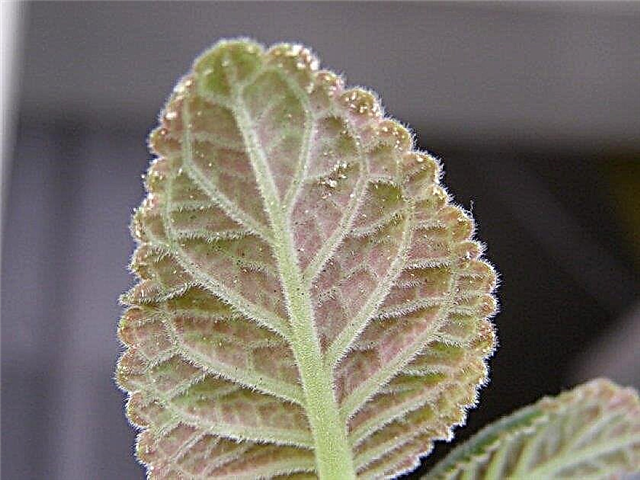
An ordinary shower that removes pests can help get rid of whiteflies, however, it is better to use standard treatment with soap or alcohol. If you want to use chemicals, you should pay attention to such drugs as “Aktara”, “Iskra” or “Fitoverm”.
Mealybug
This insect can reach a length of 1 cm, so on a houseplant it can be seen with the naked eye. It is even easier to recognize the traces of the pest - a loose white coating in the axils of the leaves and on other parts of gloxinia, which is easily removed, as well as sticky spots of honey dew.

If it was not possible to destroy the mealybug with soap, garlic or alcohol, you can use an insecticide. Almost all drugs in this category are quite effective against this pest, so you need to choose less toxic. A good option is, for example, "Dr. Foley."
Major Care Mistakes
It happens that neither the symptoms of fungal infection, nor traces of the vital activity of pests on the plant are observed, but at the same time gloxinia still looks weak and sick.
In this case, the reason must be sought in improper care: first of all, in violation of the regime of temperature, humidity, lighting and top dressing. To make it easier to understand what exactly needs to be fixed, consider how gloxinia responds to certain mistakes of the grower.
Did you know? The status of the most expensive houseplant belongs to the Shenzhen Nongke orchid. In 2005, one copy of this botanical miracle, blooming no more than once every four years, was auctioned for $ 202,000.
Why are gloxinia leaves curled
With a high degree of probability, we can assume that the cause of this phenomenon is a banal draft. Gloxinia is a tropical plant, and does not tolerate any movement of cold air (as, by the way, any sharp temperature difference). If the room temperature is lower than comfortable for the flower + 18 ... + 22 ° С, this can also cause leaf curl.

Sometimes the leaves at gloxinia not only curl, but also change shape from almost round to very elongated. This additional symptom indicates that the plant lacks light. In contrast, the appearance of brown spots on curled leaves is characteristic of a sunburn. Thus, in order for gloxinia to develop normally, it must receive a lot of light, but this light must be scattered.
Lack or excess of fertilizing
A houseplant reacts very sensitively to improper top dressing, and outwardly this is most often expressed in a change in the color of the leaves. Below are the main symptoms by which you can determine which substance the flower is missing, or, conversely, there are too many of it.
| External signs | Possible reason |
| Leaves are covered with yellow-brown spots without a pronounced shape | Excess calcium or chlorine |
| Leaves turn pale and lose their richness | Calcium deficiency |
| Leaves, especially the lower ones, become too dark, and a bluish tint appears in the color. An additional symptom is stunting, shredding of young leaves, lack of flowering | Phosphorus deficiency |
| The leaf blades turn yellow, and the veins remain green (the so-called inter-vein chlorosis) | Excess phosphorus or chlorine |
| Shoots are thinned, growth slows down, inflorescences are formed too small; leaf color turns pale, and veins turn yellow; sometimes - falling leaves, especially the lower | Nitrogen deficiency |
| Too lush and elongated bush with large dark green leaves with no flowering | Excess nitrogen |
If the problem of insufficient nutrition is easy to solve, then with excess, the situation is somewhat more complicated. In the case of a slight overfeeding of the flower, the problem mineral should be temporarily excluded from top dressing. Abundant “through” watering also helps: the plant is placed in the sink and started to fill with water, giving it the opportunity to flow freely through the drainage holes.
Important! An excess of one or another element in the soil usually manifests itself in the form of spots on the aerial parts of the plant (chemical burn), while a deficiency most often results in stunted growth and lack of flowering.
In total, 2-3 liters of water are used in this way (as with ordinary watering, it should be soft and slightly warmed up). After all excess moisture has drained, the flower pot can be placed in its original place. However, if after such a procedure the symptoms of overfeeding do not disappear, the plant urgently needs to be rescued by transplantation into fresh land.
Gloxinia begins to rot
Gloxinia tubers most often rot for four reasons:
- stagnation of water in the soil (excessive irrigation and lack of sufficient drainage);
- an excess of nitrogen fertilizers;
- improper soil composition (gloxinia prefers slightly acidic soil with a pH in the range of 5.0-6.5. If this indicator is lower, that is, the soil is more acidic, the tuber begins to rot);
- constant subcooling (including the use of cold water for irrigation).

External signs of problems with tubers are wilting, drying and falling of leaves. If the cause that caused the problem cannot be eliminated in a timely manner (sometimes this requires an emergency transplant), the plant may die.
Gloxinia does not bloom
Lack of flowering is one of the most frequent and annoying problems that arise when growing plants such as gloxinia. Unfortunately, dealing with the cause here can be much more difficult than with any other manifestations of improper care, as a refusal to bloom an ornamental plant can react to almost anything that gives it at least some discomfort.
Important! When dealing with the reasons for the lack of flowering, first of all, one should carefully evaluate all the accompanying symptoms and exclude the presence of the problems discussed above - diseases, pests, or obvious care mistakes.
If the bush looks completely healthy, but the buds on it still do not open, the problem may be:
- Irregular pot shape. Gloxinia, like many other tuber plants, feel comfortable in wide and low flowerpots. If the pot is too deep, flowering may not occur.
- Developmental disorders. All decorative-flowering houseplants need a clear alternation of the period of active growth with a period of rest. In mid-October (and if gloxinia bloomed, then immediately after the completion of this process), the pot should be rearranged in a darker place, stop feeding and radically limit watering. After such an artificial wintering, the plant will accumulate enough energy for healthy development, accompanied by abundant flowering.
- Lack of light. It is because of poor lighting that very often there are problems with laying buds: even if they appear, they turn out to be empty, not opened or not fully opened. Therefore, immediately after the completion of the dormant phase, the pot must be placed in a very well-lit place, which should stimulate the formation of strong buds.
- Hypothermia or damage to the tuber. If gloxinia wintering took place under extreme conditions (too cold air, especially with heavy watering, or, conversely, a complete lack of moisture in the soil), this can also interfere with normal flowering. In this situation, the buds are usually laid, but then blacken and fall off without opening. To help the bush recover faster, intensive lighting and therapeutic feeding with phosphorus fertilizers can.
- Too much nitrogen. This problem is worth mentioning again, since it is precisely this that causes the stubborn reluctance of gloxinia to bloom when outwardly not just healthy, but literally exudes a bush.

As can be seen from all of the above, a huge variety of difficulties can arise when growing gloxinia, and all of them, depending on the causes, are divided into three large blocks - diseases, pests and simply improper care.
Using this classification and knowing the most characteristic features that make it possible to understand in which area the source of the problem should be sought and what are the standard methods for solving it, the plant can easily be helped even without an accurate diagnosis.Important! Any houseplants grown for beautiful flowers should be fed very carefully and moderately with nitrogen.

